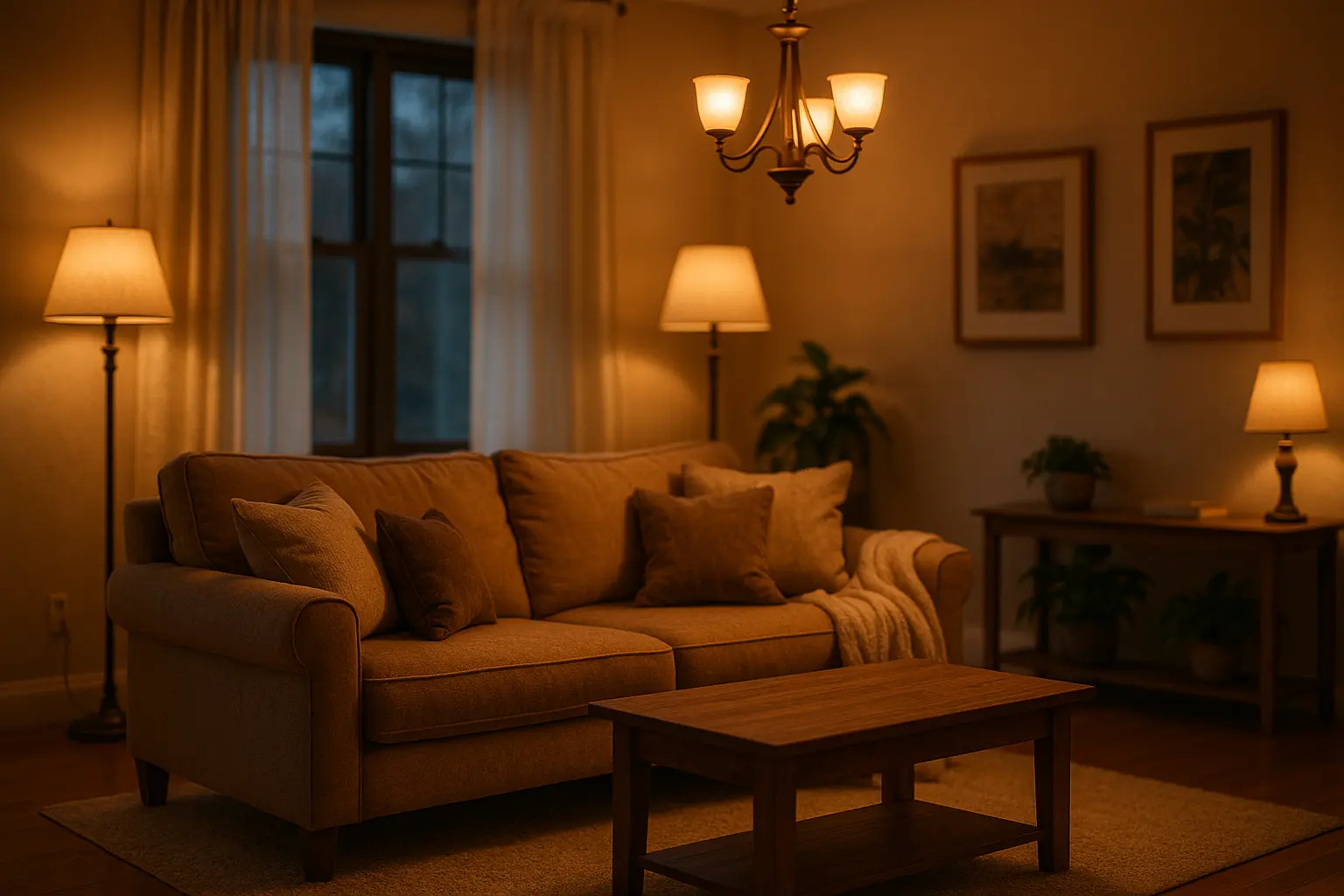In the world of interior design, we hold the key to transforming ordinary spaces into extraordinary experiences. Lighting is more than just a functional aspect of a room; it’s an art form that can create a warm and inviting atmosphere. Let us delve into the nuances of this art, exploring how the right combination of lights and colors can evoke emotions, enhance design, and ultimately, make a house feel like home.
The Power of Light: Illuminating Your Space
Lighting is the unsung hero of interior design. The difference between a dull, uninspiring room and a vibrant, welcoming one often lies within the lights we choose. Each lamp, each bulb, and each fixture plays a pivotal role, casting shadows and creating highlights that shape the feel of the entire room.
We must consider not just what we illuminate, but how we illuminate it. A ceiling light can flood a room with white brilliance, while a carefully positioned table lamp can cast a softer, more intimate glow. Every light source adds its own art to the room, contributing layers that are crucial to the overall design.
Crafting Ambiance with Color and Light
Color goes hand in hand with light to define a room‘s atmosphere. When paired adeptly, they can fill a space with warmth or create a cool, refreshing feel. Warm lights like those with yellow or orange hues can make a room feel cozy and inviting. On the contrary, white or blue-toned lights can lend a modern, fresh design to a space.
Illuminating Art and Function
Lights can highlight the art within a room, from a beloved painting to a carefully curated sculpture. By directing a well-placed lamp or accent light on these pieces, we can draw attention and add depth to the space. Yet, we shouldn’t forget the practical side of lighting; it should seamlessly blend design with function, ensuring that every room serves its purpose efficiently.
Layering Light: A Multidimensional Approach
Approaching lighting with layers allows us to enhance the room‘s ambiance and add depth. Think of each light source as a layer of art that contributes to the room’s overall atmosphere. With this mindset, we can create spaces that are not only functional but also visually captivating.
Ambient, Task, and Accent Lighting
We start with ambient lighting, the backbone that provides general illumination. This could be a ceiling fixture that fills the room with a soft glow. Next comes task lighting, designed to illuminate specific areas for activities like reading or cooking. This might be a table lamp beside a favorite chair or under-cabinet lights in the kitchen.
Finally, accent lighting adds a touch of drama. Strategic placement of such lights can highlight a feature wall, a piece of art, or architectural details, creating focal points that draw the eye.
The Balance of Nature and Artificial Light
Natural light is a gift, its tones shifting with the day. By complementing it with artificial lighting, we maintain balance and harmony throughout the space. A room with large windows might use sheer curtains to diffuse the sunlight, while lamps and wall sconces take over as evening descends.
The Psychological Impact of Lighting
Lighting profoundly affects how we perceive and experience a space. It’s not just about aesthetics; lights can significantly influence our mood and mindset. We must consider the psychological impact when designing interiors that aim to enhance well-being and productivity.
Creating Atmospheres for Different Rooms
Each room serves a distinct purpose and requires tailored lighting to cater to its unique function. In the living room, where relaxation is paramount, warm, ambient lights can foster a sense of tranquility. In contrast, a home office benefits from white, focused lighting that encourages concentration and increases productivity.
Building Comfort and Coziness
In spaces like bedrooms and lounges, the goal is often to create a cozy, intimate atmosphere. Here, dimmable lights and layered lighting come into play. By adjusting the intensity, we can shift the room‘s feel, offering comfort and promoting relaxation.
Lighting as a Mood Enhancer
Certain lights can evoke specific emotions. Blue-toned LED lights can offer a serene, calming atmosphere, while red tones might create a passionate, energetic vibe. This understanding allows us to design spaces that truly reflect the desired emotional environment.
As we’ve explored, lighting is a powerful tool in the realm of interior design. By considering the art of lighting, we can create spaces that are not only functional but also atmospheric and emotionally resonant. Our lights can transform a simple room into an inviting sanctuary, a vibrant hub, or a serene retreat. Let us embrace the potential of light to illuminate new possibilities in every corner of our homes.
FAQ
How can I choose the right lighting fixtures for my living room?
Selecting lighting for your living room involves considering the room’s purpose and mood. Opt for a mix of ambient lighting, such as ceiling fixtures, with task lighting like floor lamps, to create a balanced atmosphere. Make sure the styles complement your décor.
What type of lighting is best suited for a cozy bedroom ambiance?
For a cozy bedroom, focus on using soft, warm lights. Consider table lamps or wall sconces with dimmers, allowing you to adjust the brightness based on your needs and mood. Avoid overly bright lighting to maintain a soothing environment.
Are there any tips for effectively lighting a home office?
In a home office, prioritize task lighting that reduces eye strain and shadows. Choose adjustable desk lamps with LED bulbs for clear, focused light. Incorporating natural light, if possible, can also enhance productivity and comfort.
How can I use lighting to enhance the atmosphere in my dining room?
In the dining room, a central fixture like a chandelier or pendant light can serve as a focal point. Use dimmers to adjust the light intensity according to the occasion, creating an intimate setting for dinners or a brighter one for gatherings.
What are some creative ways to use lighting in a bathroom?
To elevate your bathroom design, use layered lighting. Combine overhead lights with wall-mounted fixtures beside or above mirrors for even illumination. Consider using LED strips under vanities or around mirrors to add a modern touch.


